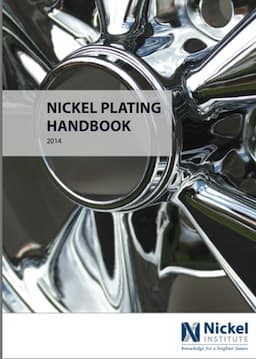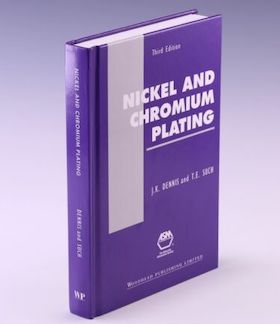
Curated with aloha by
Ted Mooney, P.E. RET

The authoritative public forum
for Metal Finishing 1989-2025

-----
Dummy plating copper from nickel bath
Q. I am looking for a starting point for setting up a plate out cell to remove low levels of Cu (10-20 ppm) from a nickel sulfamate plating solution. We are setting up a cell with a cathode, anode, and rectifier to pump solution through that we can use to remove Cu while we continue to plate in the main plating cells. Obviously we will plate Ni on the corrugated dummy cathode while we are removing Cu. What I am looking for is either the proper voltage setting, or current density to reduce the amount of Ni plated out while preferentially plating Cu. With a corrugated dummy panel we will have a current density range, I am looking for a place to center the range. Is there any reference material on this?
Rich Reifenheiser- Fountain Inn, South Carolina
1998
A. There isn't really a rule, Mr. Reifenheiser, because it depends on what current density you are electroforming at. The principle that is in play here is simply that the lower the current density, the more it will favor copper. So if you are electroforming at 20-50 ASF, then dummy at, say 5 ASF. But I know of one application that is electroformed at 1 ASF, such that dummying at even 1 ASF would be much too high. And some electroforming is done at 400 ASF or more, where dummying could probably be successfully done at as high as 10 ASF.

Ted Mooney, P.E.
Striving to live Aloha
finishing.com - Pine Beach, New Jersey
A. If you do not want to plate out a lot of your nickel, dummy at the lowest amperage that will do the trick. 2 - 3 ASF removes very little nickel relative to the amount of trash metals removed. If you can get by with continuous dummy, try 1 ASF.
James Watts- Navarre, Florida
Q. Hello,
In our company we use Watts-type nickel solution which includes nickel sulphate, nickel chloride and boric acid and organic additives as mixtures. Operating temperatures can range from 55 to 65 C, pH is normally 3,5-4,6.
On a barrel line we have three containers with nickel electrolyte. Each container has 3 positions.
We filter electrolytes with Aprochim filters and activated carbon.
The filtration by Aprochim filters is used to remove particles, which were introduced by the workpieces/substrate, and anode mud. The filter is operated in a bypass to the process tank.
Electrolyte, in which different decayed organic products are accumulated after a longer period of working, is pumped through the actived carbon into the spare bath when the line is stopped for a longer period of time.
Activated carbon is mixed into the electrolyte and removed by filtration after a suitable reaction time.
My question:
I would like to know how dummying process works? I would like to know some more informations about rectifier (voltage, power, supply).
I am very interested in this solution cleaning process but I don't have enough information how to manage it?
Please help me!
Best regards,
electroplating technologist - Slovenia
May 16, 2008
|
|
A. My Opinion: - Navarre, Florida A. Dummying means "electrolytic purification", the plating out of copper and zinc in your case. First run a Hull Cell test before and after "dummying". Plate a 2 amp panel and set it aside. Then dummy some solution for one hour at 1/4 amps in the Hull Cell. Then plate another 2 amp panel and observe the difference. If improved, then proceed to dummy the whole tank. Prepare a mild steel sheet 2/3 the depth of your solution, bend it in zig-zag sections, each section being 3 inches, the angle being about 30 degrees. Electroplate this panel to cover the iron, then turn the current down to 2 amps per square foot and plate overnight. The zinc and copper will come out in the deep recesses of the zig-zags.  Robert H Probert Robert H Probert Technical Services Garner, North Carolina  |
Q. Dear all,
We are doing Ni/Au barrel plating for pogo pin connectors.
Our Nickel sulfamate plating bath consists of 270L PP tank and 2 anodes with 5 kg INCO R-Rounds Electrolytic Nickel in each 12*12*2 inch Ti basket.
There is something we can't understand: Bath Voltage when we do dummy plating using a 28dm^2 dummy plating cathode.
First bath voltage is ~0.8V, when current density is 0.1ASD. Then bath voltage will slowly increase from 0.8V to 2.5V. We don't know why. What is the mechanism in this situation. Is it any anode passivation, capacitance effects or something?
Thanks a lot for your help.
- Taipei, Taiwan
February 26, 2013
A. Hello Clark,
As you may know higher voltage = increased resistance. It is odd that you only experience this in dummy plating and not in your production barrel plating. First I would check all anode and cathode connections, and make sure they are getting good contact. Inspect your dummy plating cathode rack. I set a meter for ohm resistance (continuity) and attach one lead to the rack / cathode connection point then the other at the bottom of the cathode dummy. Your continuity should not exceed 0.5 ohms. Make sure anode and cathode bars are clean. I assume that your rectifier cabling is adequate for the current density that you are using. You can also use a clamp meter set at DC amps. Check your current on both the cabling before the anode and cathode connections. Both readings should be similar. If space allows I also like to check the current around the anode hooks with the clamp meter. Hope this helps.
Process Engineer - Mesa, Arizona USA
|
|
A. Hi,  Anders Sundman 4th Generation Surface Engineering Consultant - Arvika, Sweden A. Hello Clark, Process Engineer - Mesa, Arizona, USA |
A. Hi: If you really want to get the copper out of your bath, use the lowest current that you can get on your rectifier. Set your dummy panel in the bath; set your rectifier to zero; and move your knob to increase power very, very slowly, when you see a minimal movement around your panel, you are good to go.
Dummy for 24 hours, and next day all you will see is only copper and no nickel. You can go as low as half volt.
Regards,
- New York, New York
Q.
Hello, I came across this site while searching some info on plating solution.
I read all the answers about dummying of copper. Some was suggesting to plate the solution in low current in order to remove copper.
So, my question is why do we need to use low current in order to dummy copper?
I really appreciate your opinion.
Thank you.
- Johor, Malaysia
September 3, 2014
A. Hi Atiqah. Picture keeping the current very low, and thus having just a few excess electrons present on a dummy cathode sheet sitting in a nickel plating solution that is contaminated with copper. Those sparse electrons have many positively charged ions of nickel and copper around them to choose from, and they will reduce only a few of them. For reasons that I partially understand but don't fully understand, the copper ions are hungrier to mate with the electrons than the nickel ions are; consequently, the copper will plate out onto the dummy sheet in preference to the nickel.
Now, turn the current way up so there is an abundance of excess electrons on the dummy sheet clamoring to mate with positively charged ions and reduce them to metal. At any small given area the copper ions will rapidly be used up, and there will be no more immediately available there, so the hungry electrons, which must be satisfied, will neutralize and plate out nickel ions as nickel metal -- but your objective was not to remove nickel from the solution.
Thus, it is not so much the case that "low current is needed to remove copper" as it is that high current will wastefully remove nickel.
Regards,

Ted Mooney, P.E.
Striving to live Aloha
finishing.com - Pine Beach, New Jersey
Q, A, or Comment on THIS thread -or- Start a NEW Thread

